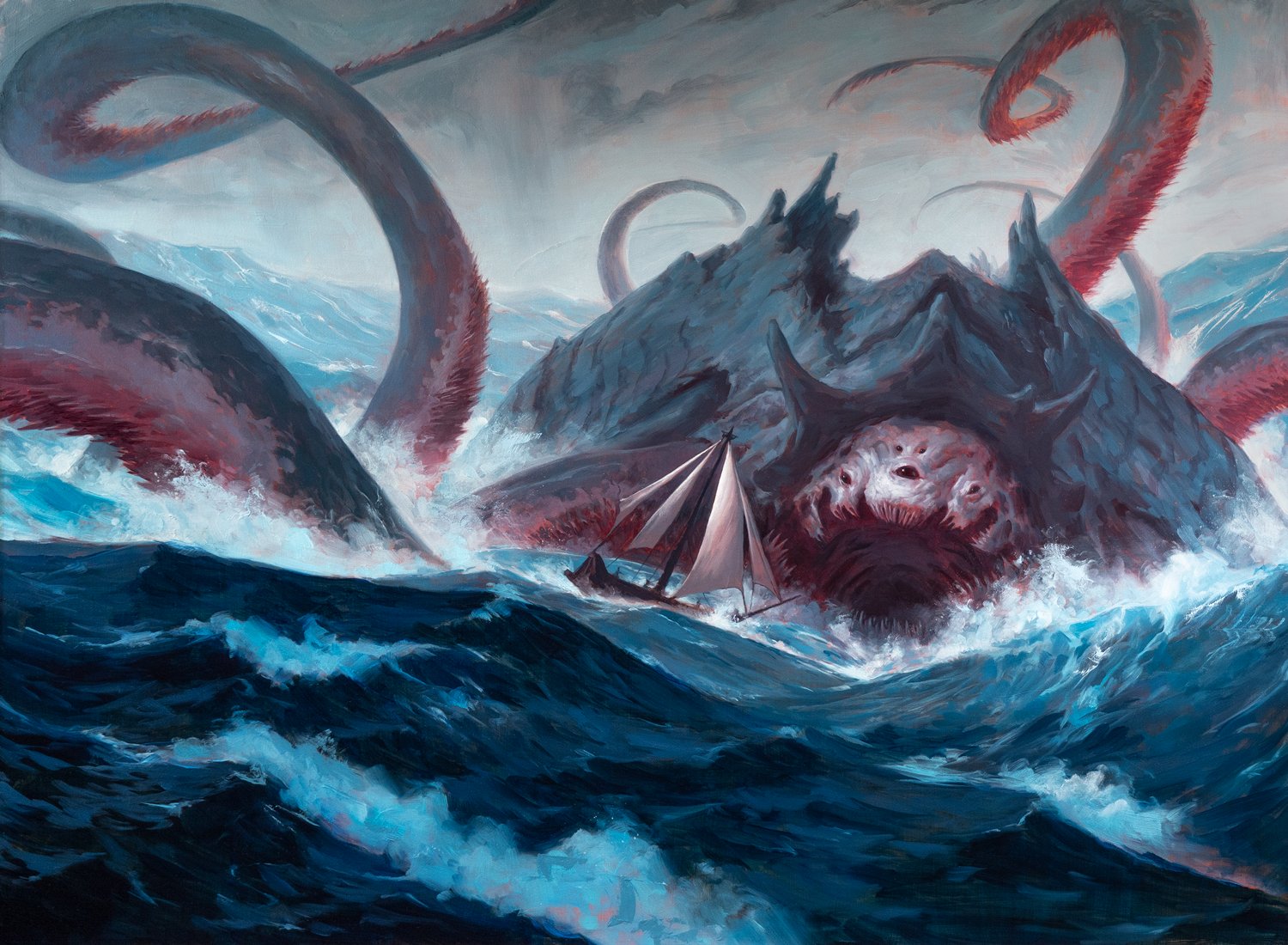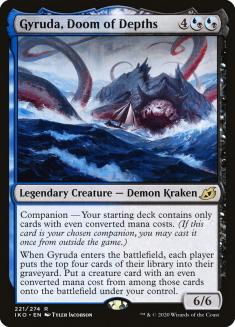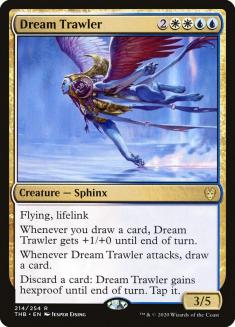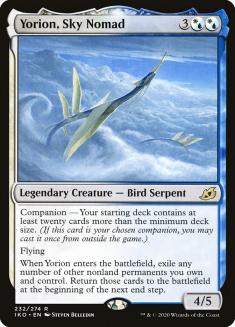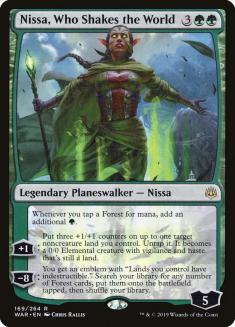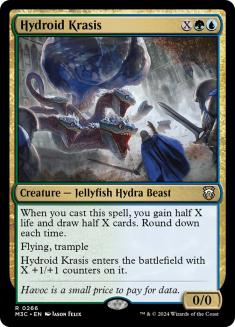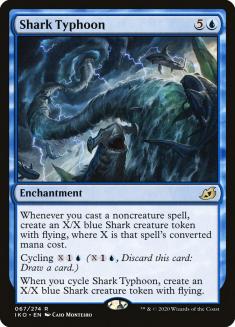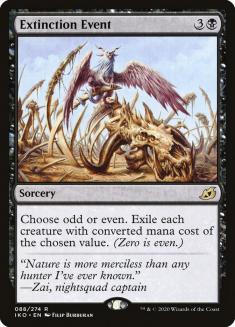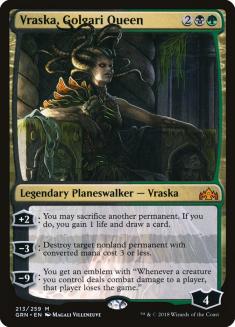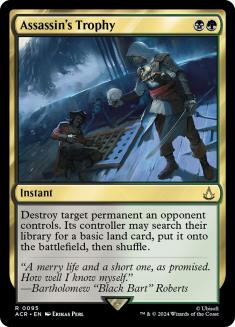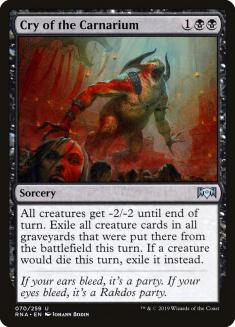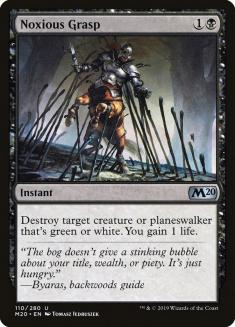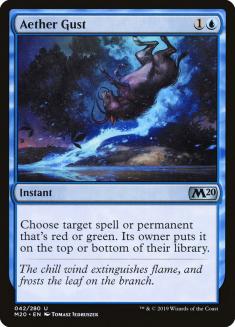Dimir Control has been a blast, but I cannot settle in with one control deck with all the available options we have. There are far too many powerful control cards from the Ikoria, as well as from the previous sets of Standard, to fully invest in one color combination from the start. With all these options before us, the challenging piece is determining which is best-suited to deal with the avalanche of companion threats that has cascaded into the format.
Standard is typically a low-powered, slower format. Even when Mono-Red Aggro is at the top, slower decks still have a place in competitive play. This does not hold true in older formats, where games are over in the early turns. Unfortunately for those of us who love a drawn-out game of Standard, companions have accelerated the format to unrecognizable speeds. Gyruda, Doom of Depths was the initial offender of Standard, providing unbeatable battlefield positions as early as Turn 4. Even before the multiple copies of Agent of Treachery have hit the battlefield, opponents were aware of their impending doom from the obvious, guaranteed setup that preceded them. These Gyruda, Doom of Depths deck have slightly declined in popularity recently, but that is only because other companions have taken the spotlight.
Lurrus of the Dream-Den is the most damaging companion across all formats so far, with a cost that is laughably low for aggression-minded people. Having all the low converted mana costs in an aggro player’s deck was already a given, with the three-mana cards being in the form of spells. This is easy to perform in older formats but somehow it has infested the Standard format right off the bat. Decks are having to contend with eight-card hands, one of which is always the best card to have at the end of the curve. This is problematic for decks that cannot specifically interact with threats as they appear, creating uniform and boring gameplay for many players. Fortunately for the control population, we can gear our decks to beat decks like these.
Control shines when the metagame is defined or when the win condition is too powerful to care what else is around it. Dream Trawler was the latter for us, coming down on Turn 6 and ending the game shortly after. This was the dream scenario for control and led to Azorius Control dominating the format for a period. We are edging back toward the former, having these companion-based decks being forced by the competitive community. I say “forced;” however, it is for a justifiable reason.
Companions are too good, and the rest of the community is well aware of it. This is going to be another mistake that Wizards of the Coast (WotC) must handle, but I do not think the format is lost in the meantime. Control is well-positioned to handle the array of obvious decks coming down the pike. Essence Scatter should be in every control deck moving forward and I will be hard-pressed to move away from black for the time being. Jeskai Control has some great options that go together with its own companion, Yorion, Sky Nomad, but I do not think that is the direction to go just yet.
It is not a huge opportunity cost to add twenty more cards to your starting deck, so I foresee Yorion, Sky Nomad being a control staple. At this point in the format, I am having success with my 60-card versions of Sultai, Jeskai, and Dimir Control. I believe that the three-color decks will move to 80 cards soon due to the amount of options available in those colors. Let us see how the format plays out this week with the amount of data being gathered from MTG Arena, which will help me move in that direction if it becomes painfully obvious that 60 cards are a thing of the past. For now, I am afraid to bust up this well-oiled machine.
Creatures (7)
Planeswalkers (4)
Lands (24)
Spells (25)

Dimir Control has been kind to me; however, the green cards in Standard are too good to pass up on. Even after a couple were banned, the remaining options are prime control targets. Uro, Titan of Nature’s Wrath is a beautiful win condition for decks that do not like playing a bunch of creatures. It gives us additional land drops, a cantrip, and some life early, returning later in the game as an overpowered threat. It is no secret that it is one of the best creatures printed, as it has shown its dominance in all competitive formats.
Uro, Titan of Nature’s Wrath is the reason to move into green, but it brings a few friends with it.
Nissa, Who Shakes the World joins forces with control to produce a constant source of pressure, mana, and a looming ultimate that can swiftly end the game. This planeswalker arguably should have been removed from the format in the wave of action that took Oko, Thief of Crowns, but I am glad it stayed. It is a very strong card, but new cards from Ikoria have shown that WotC easily have outdone themselves. Companions are dominating the banning chatter lately, letting these green cards from previous sets off the hook, and Nissa, Who Shakes the World is not the only blast from the past that is teaming up with Dimir Control elements.
Hydroid Krasis is a control card as its core. Right when this card was previewed, I crafted a Sultai Control deck that I took to the Pro Tour shortly after. I played a deck that is very similar to the one above, but there were some elements missing from that deck that we have filled here. Hydroid Krasis provides an outlet for the mana advantage provided by Growth Spiral; Uro, Titan of Nature’s Wrath; and Nissa, Who Shakes the World. The lifegain that these older green cards provide Sultai Control is finally utilized, whereas the midrange versions was less desperate for that effect.
Hydroid Krasis competes directly with Shark Typhoon, which I covered in detail during preview season. Both options find a solid home in Sultai Control and the Zagoth Triome makes it all work out. If an Esper Triome were around, I think my crafting hours might have been utilized differently. It may be best for all of us that I am forced to work outside of my comfort zone for this new Standard and help provide a strategy that can take down enemy companions with ease.
The green win conditions have added another dimension to the traditional control deck I featured last week. Not only are these cards at the top end of power level, they all support the general strategy that each control deck aspires to carry out. Keeping the life total comfortable, providing card advantage, and resiliency are all showcased by the green base in Sultai Control. The old cards received some help from the new as well.
I laid out the reasons why I thought Extinction Event was fantastic and should be played over Ritual of Soot last week. This was one of my better predictions, because it was spot-on. I could not believe how smooth it was in Dimir Control and that success caries on to other types. The rest of the community is catching on to the power of Extinction Event, so expect to see it as a format staple moving forward.
I paid a four-mana premium to exile creatures in the past and this removal spell has a mile of upside. It has been better than Shatter the Sky in most scenarios due to exile and keeping your own creatures alive. A lucky circumstance of this Sultai Control deck is that all the creatures, including those from planeswalkers and spells, are even. This means that anytime an odd sweep is required, it often leaves a threat of ours alive. I could go on about Extinction Event for hours, but we must move on. Let us just say that I am not missing Shatter the Sky as much as I should.
The rest of the spells in Sultai Control are the best of the Dimir Control deck combined with some green-based removal. Vraska, Golgari Queen and Assassin’s Trophy are clean removal spells to many of the threats that get past the hand disruption and counterspells. I had some other planeswalker removal in here at the beginning, but quickly realized that both Golgari cards do it better in the current metagame. Thought Erasure pulls the heavy lifting at the beginning of the game to ensure that the planeswalker removal is not stretched too thin. It is joined by Neutralize and creature threats to keep the battlefield safe from them. Creatures are effectively dealt with through Essence Scatter, Heartless Act, and Extinction Event Game 1, but the sideboard is where the real magic happens.
The bread and butter of control in the current Standard is having access to Cry of the Carnarium. It has always been a useful tool; however, it is time for it to carry control to victory on its own. Lurrus of the Dream-Den taunts control players into using Cry of the Carnarium, so I obliged. Not only am I accessing it for the sideboarded games, there will be four that enter the arena. I have learned a long time ago that messing around with fewer than four copies of cards used to defeat the best deck in the format is a huge mistake. Playing a deck that receives zero punishment from a spell like Cry of the Carnarium is exactly where I want to be if Lurrus of the Dream-Den is being heavily leaned on.
I do not think Lurrus of the Dream-Den is the best companion of Standard and it will be overshadowed eventually. This take does not apply for any other format, where it clearly is too good, but slower decks in Standard can adapt to little creatures. Cry of the Carnarium is the obviously the best, but simple sweepers can handle the workload well enough. It just so happens that Sultai Control has the best version of it and will be able to handle aggro decks easily.
The rest of the sideboard contains staples from my other control decks that share colors with Sultai Control. Noxious Grasp and Aether Gust are fantastic hate cards that will see play for a very long time. It is tough not to include these answers when able. The basis for Azorius Control’s success was having four Devout Decree to clean up red threats for a low cost. Noxious Grasp was also a four-of at certain points in the format, especially during the reign of Oko, Thief of Crowns.
The counterspell count in the maindeck is low because of the amount of aggro decks being played online. The sideboard makes up for the deficit, adding five more; a couple of Narset, Parter of Veils; and a Tamiyo, Collector of Tales for the grindier matchups. These are cards that I had in the maindeck at some point but had to cut down on in order to create a better Game 1 against the field.
As the format changes, expect to see a little less removal and a little more blue interaction. Let’s take down companions, and the aggro community, with a little help from the green villains out there.

